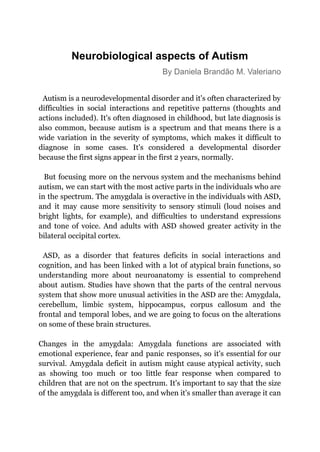
Neurobiological aspects of autism. Coursera project
- 1. Neurobiological aspects of Autism By Daniela Brandão M. Valeriano Autism is a neurodevelopmental disorder and it's often characterized by difficulties in social interactions and repetitive patterns (thoughts and actions included). It's often diagnosed in childhood, but late diagnosis is also common, because autism is a spectrum and that means there is a wide variation in the severity of symptoms, which makes it difficult to diagnose in some cases. It's considered a developmental disorder because the first signs appear in the first 2 years, normally. But focusing more on the nervous system and the mechanisms behind autism, we can start with the most active parts in the individuals who are in the spectrum. The amygdala is overactive in the individuals with ASD, and it may cause more sensitivity to sensory stimuli (loud noises and bright lights, for example), and difficulties to understand expressions and tone of voice. And adults with ASD showed greater activity in the bilateral occipital cortex. ASD, as a disorder that features deficits in social interactions and cognition, and has been linked with a lot of atypical brain functions, so understanding more about neuroanatomy is essential to comprehend about autism. Studies have shown that the parts of the central nervous system that show more unusual activities in the ASD are the: Amygdala, cerebellum, limbic system, hippocampus, corpus callosum and the frontal and temporal lobes, and we are going to focus on the alterations on some of these brain structures. Changes in the amygdala: Amygdala functions are associated with emotional experience, fear and panic responses, so it's essential for our survival. Amygdala deficit in autism might cause atypical activity, such as showing too much or too little fear response when compared to children that are not on the spectrum. It's important to say that the size of the amygdala is different too, and when it's smaller than average it can
- 2. cause anxiety disorders. When it is larger, it is associated with behavior disorders. Changes in the cerebellum: Cerebellar dysfunction plays a really important role in ASD, because it's associated with communications deficits and repetitive behaviors. Cerebro-cerebellar loops are important to cortical development, but autism might cause an interruption of the specialization of cortical regions involved in motor control (causing problems with balance and coordination), language, and social interaction. Changes in the hippocampus: It's often larger in children and teenagers with ASD, and it may be related with difficulties forming new memories. Frontal and temporal lobes: Enlargement of different brain areas was found in both gray and white matter volumes, in the frontal and temporal lobes. It's important to say that the differences in the autistic brain doesn't mean it's worse than the typical brain, in fact, many autistic people have gifts in areas such as memorization, visual thinking, ability to focus on details, logical thinking ability and many others. On the YouTube video “ The autism experience”, Samuel Beldie talks about his experience being autistic and the struggles he finds in life. He also says that autistic people may do things that are considered awkward, but it's because their brain structure it's different, and it may cause difficulties with emotion and communication but are gifted in other aspects, like the ones written above. His speech is very important, because despite all the difficulties that autism brings, they are very intelligent, capable and deserve respect. To conclude, “Understanding the Brain: Neurobiology of Everyday Life” was a very helpful course to me in this journey of learning more about the brain, and its anatomy and functions of every part. It made me realize how incredible and fascinating the brain is and how everything works (neurons, synapses, abstract functions, vision, hearing and many more fascinating topics). It was enriching, not only for my academic life, but for understanding more and developing more empathy for people
- 3. facing the most diverse types of neurological disorders, such as aphasias, autism, amnesias and many others. Sources: https://youtu.be/7L5Bh1TCcGc?si=vVbV439sahxE_Zob https://www.nimh.nih.gov/health/topics/autism-spectrum-disorders-as d https://www.integrityinc.org/what-are-the-5-types-of-autism/#:~:text= There%20are%20five%20major%20types,developmental%20disorder% 20%E2%80%93%20not%20otherwise%20specified. https://www.ncbi.nlm.nih.gov/pmc/articles/PMC7287879/ https://www.autismparentingmagazine.com/how-autism-affects-amygd ala/ https://www.frontiersin.org/journals/neuroscience/articles/10.3389/fni ns.2015.00408/full https://www.thetreetop.com/aba-therapy/how-do-autistic-brains-work https://www.altogetherautism.org.nz/strengths-and-abilities-in-autism/